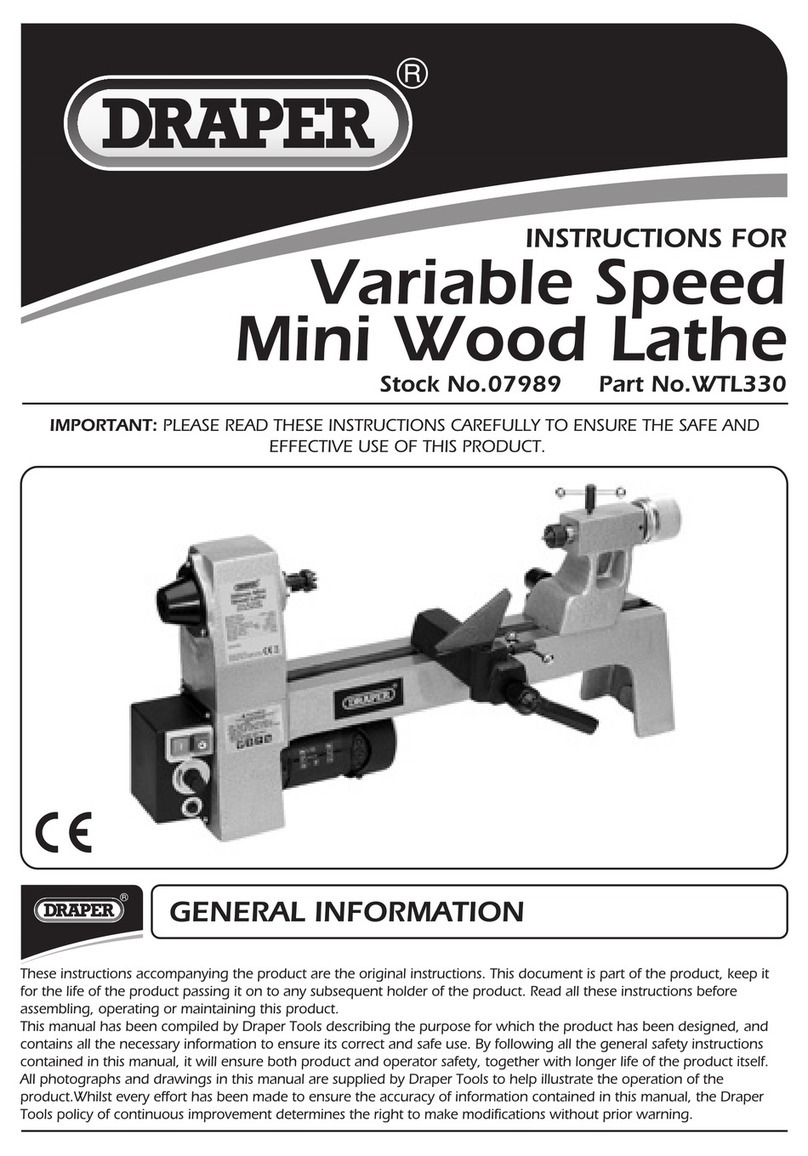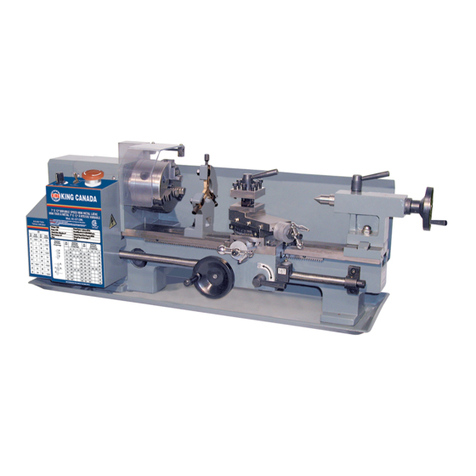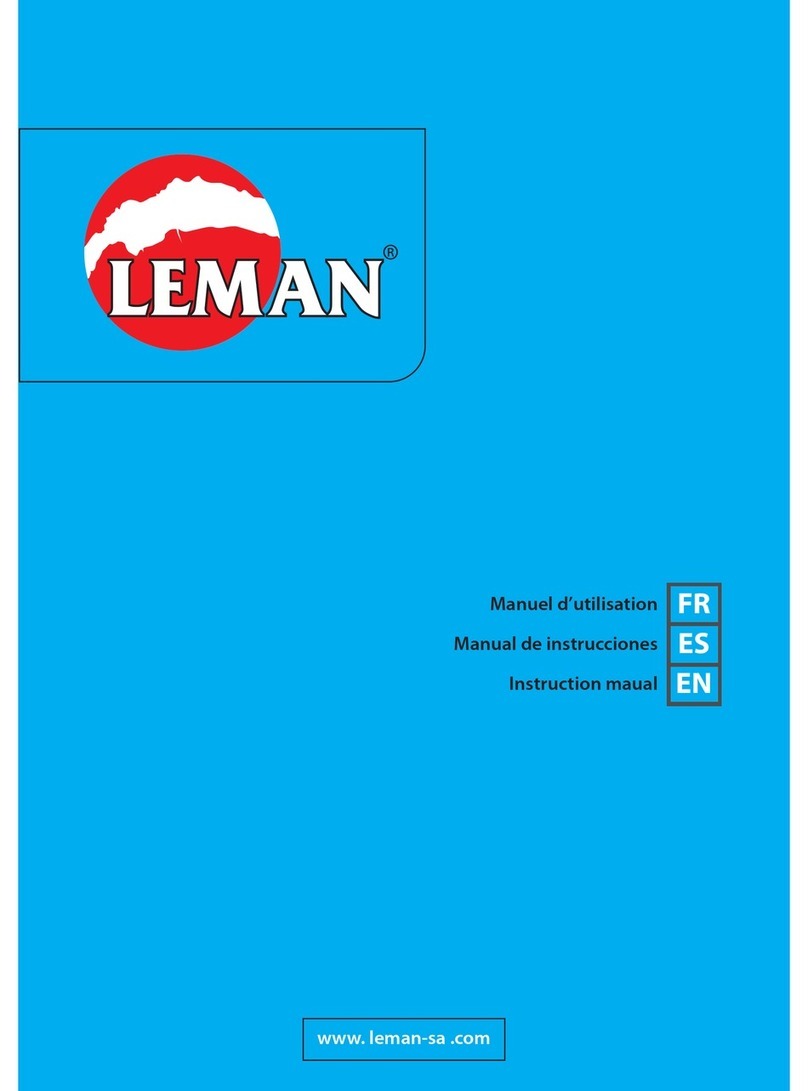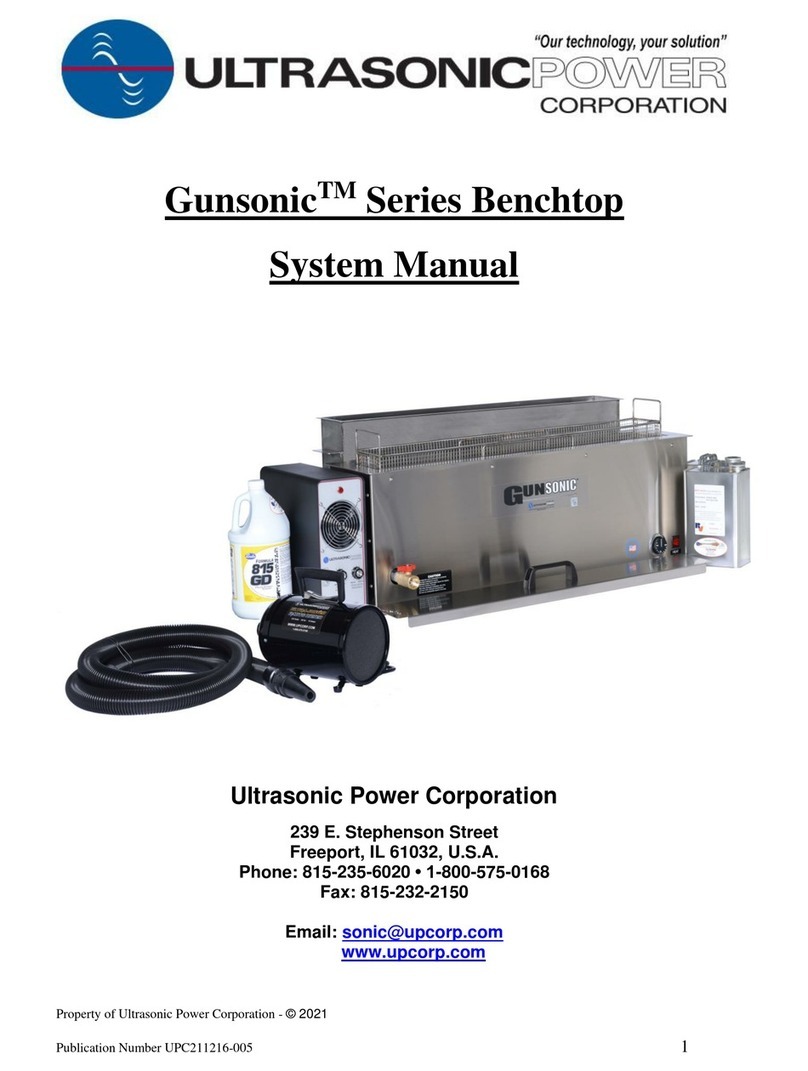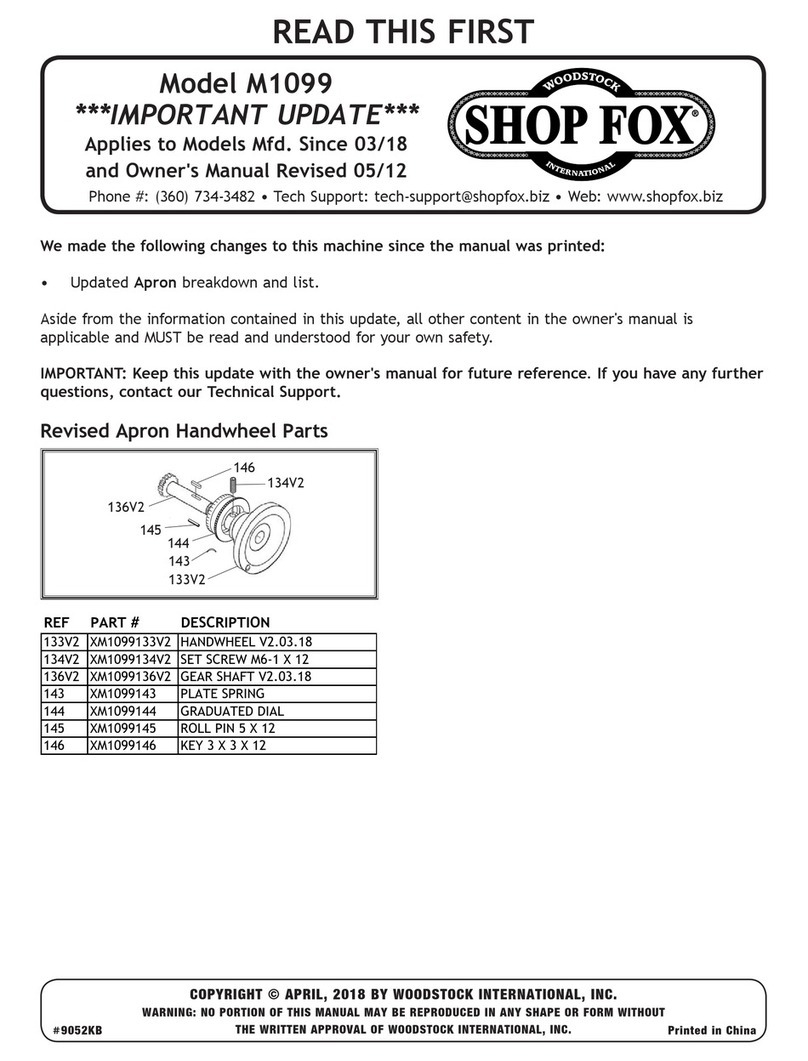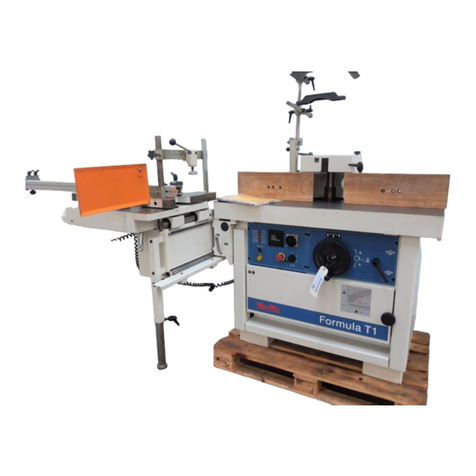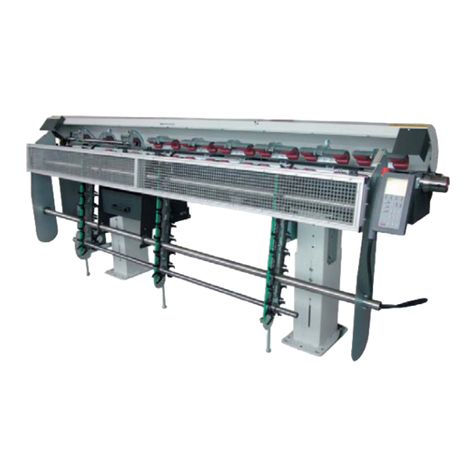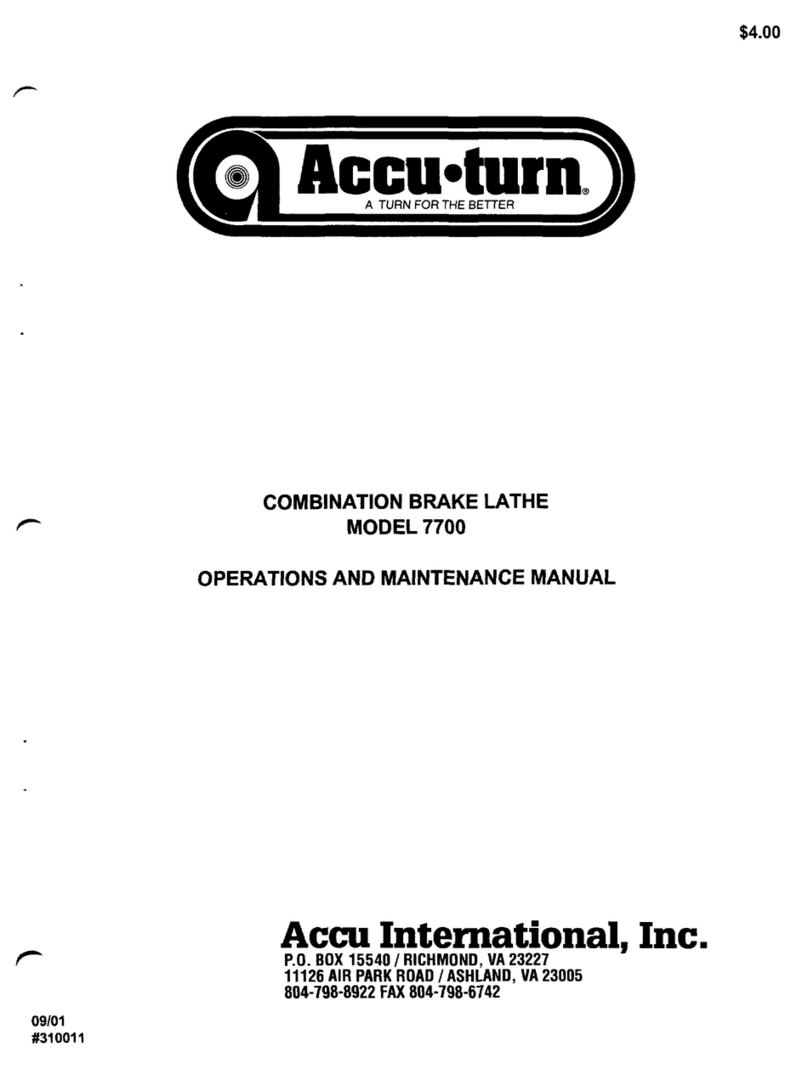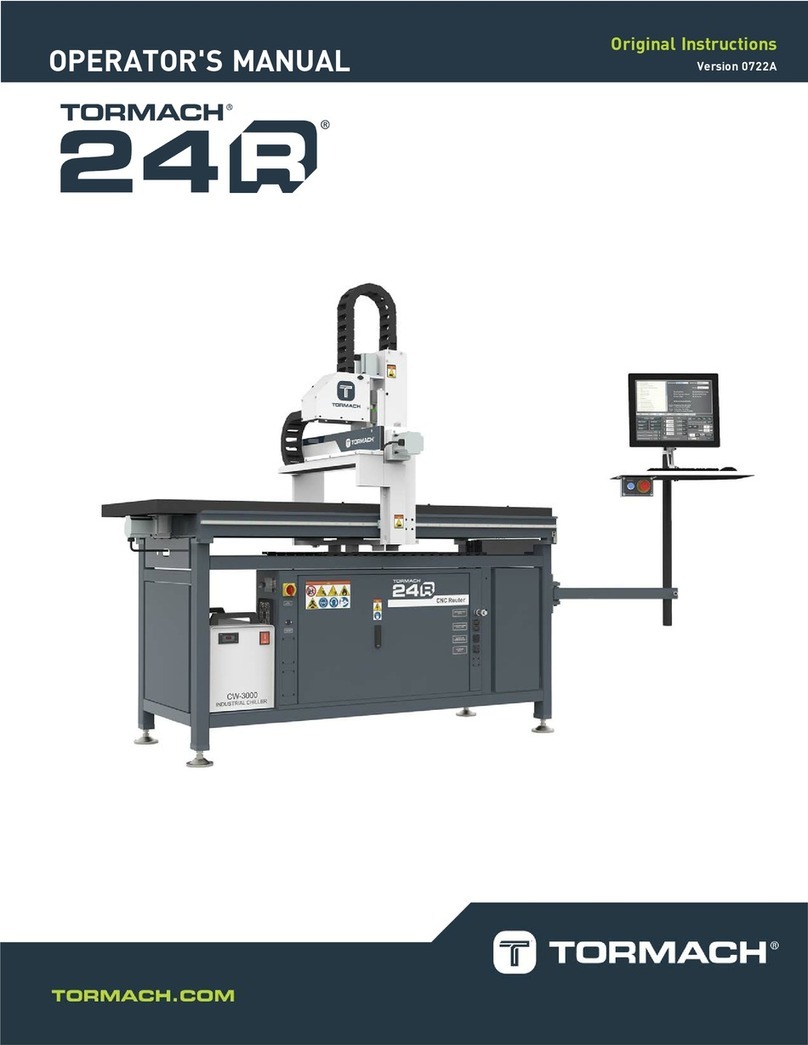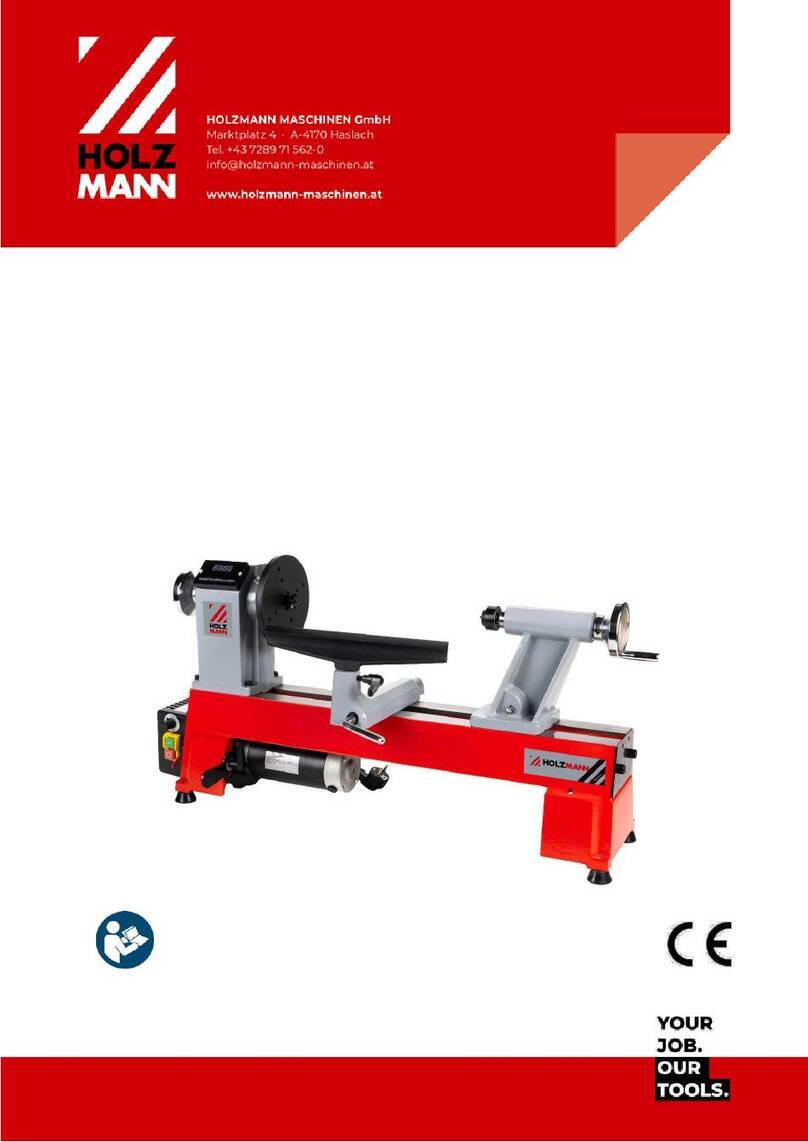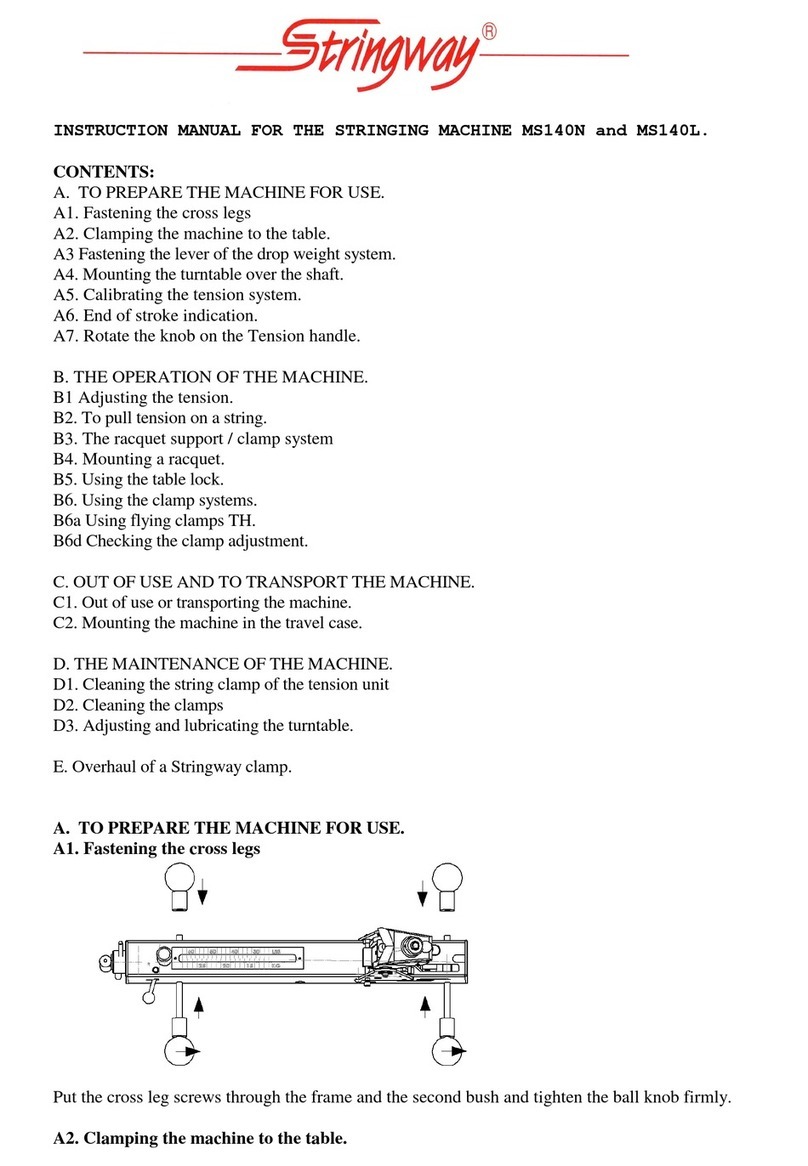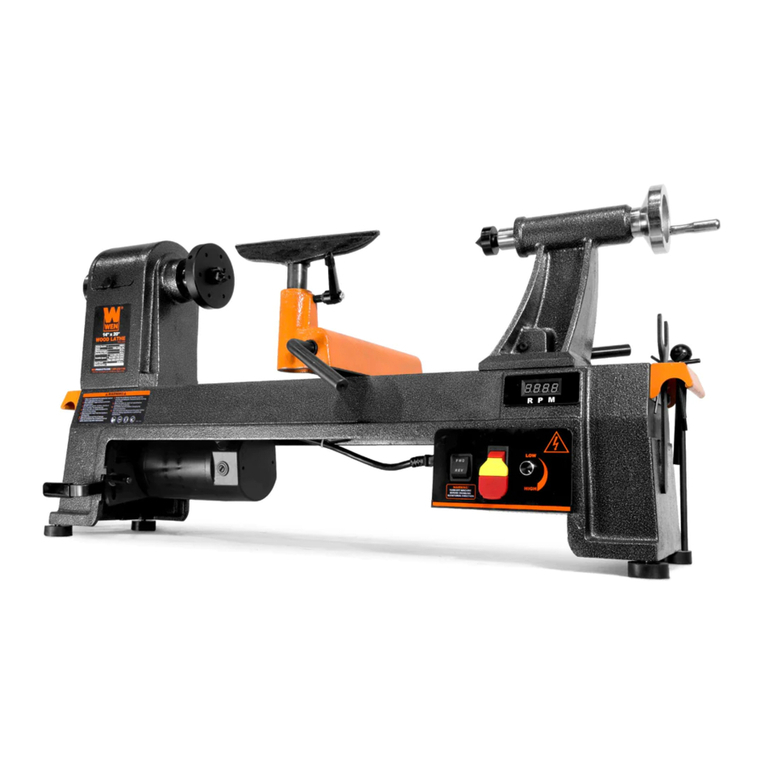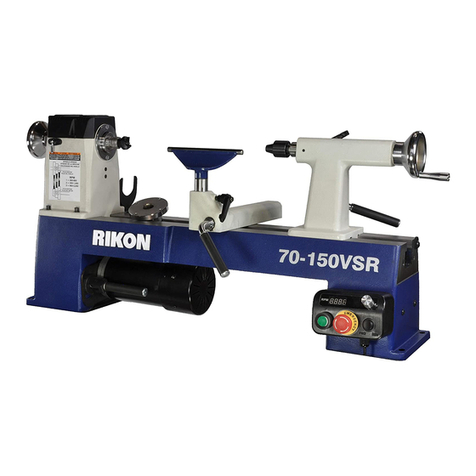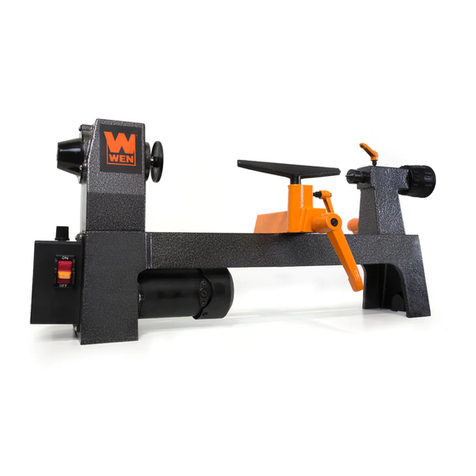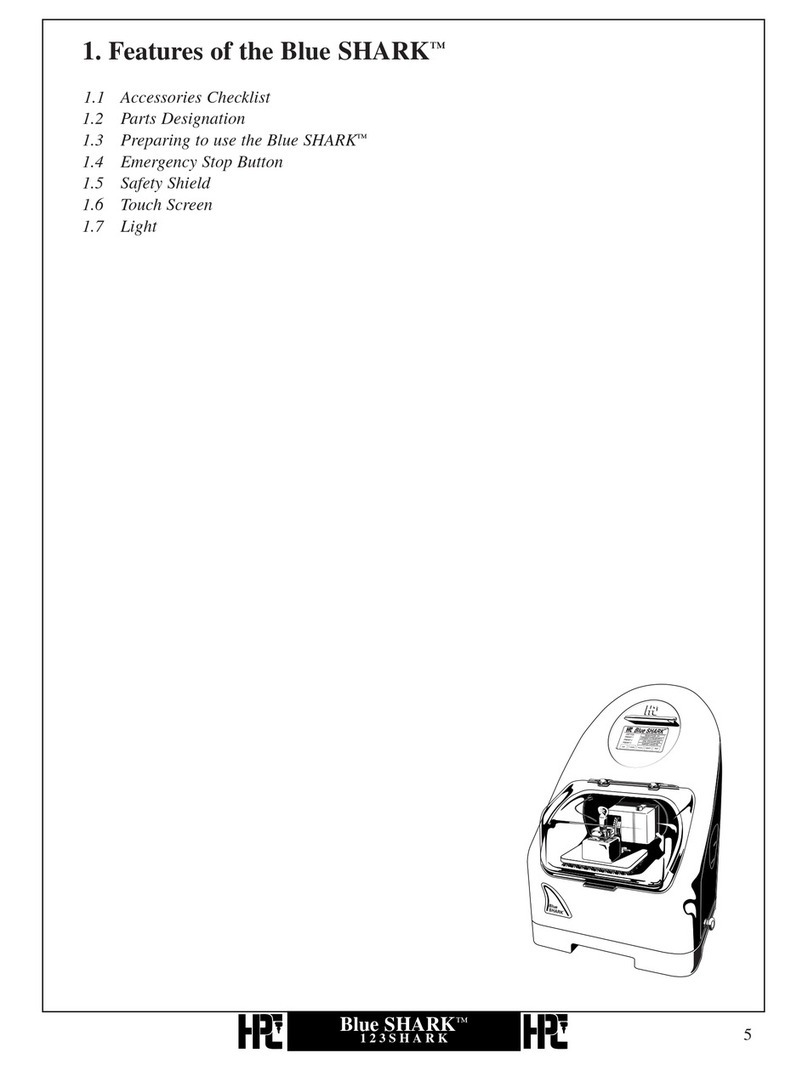Newman EPR Series User manual

SERVICE
MANUAL
EPR Series
Electric Drive
Double Roughing Planer
Equipped with Helical Carbide Cutterheads
Edition 1.4
Issued 9/12/2000
NEWMAN
QUALITY WOODWORKING MACHINERY
SINCE 1906

EPR-18 and EPR-24
Helical Carbide
Double Roughing Planer
Service and Parts Manual
Version 1.4

This Page Intentionally Left Blank

I
Table of Contents
1 GENERAL INFORMATION................................................................................................. 1
1.1 Warranty ......................................................................................................................... 1
1.2 Safety Practices............................................................................................................... 3
1.3 Basic Safety Procedures.................................................................................................. 5
1.3.1 Safe Operating Practices......................................................................................... 6
1.3.2 Lumber Jams........................................................................................................... 7
1.4 Receiving ........................................................................................................................ 8
1.4.1 Unloading................................................................................................................ 8
1.4.2 Checking Shipment................................................................................................. 8
1.4.3 Cleaning ..................................................................................................................8
1.4.4 Extended Storage .................................................................................................... 8
1.5 Installing The Planer..................................................................................................... 10
1.5.1 Foundation ............................................................................................................ 10
1.5.2 Accessory Equipment ........................................................................................... 17
1.5.3 Electrical ............................................................................................................... 19
1.5.3.1 Electrical Requirements .................................................................................... 19
1.5.3.2 Care Of Electrical Equipment........................................................................... 19
1.5.4 Compressed Air Requirements ............................................................................. 20
1.5.5 Dust Collection Requirements .............................................................................. 20
1.5.6 Start-Up Procedures .............................................................................................. 21
2 THEORY OF OPERATION................................................................................................. 22
2.1 Planer Description......................................................................................................... 22
2.2 Automatic Cut Control............................................................................................. 23
2.3 Controls......................................................................................................................... 24
2.3.1 Operator’s console ................................................................................................ 24
2.3.2 Feeder Console (Optional).................................................................................... 27
2.4 Planer Adjustments ....................................................................................................... 28
2.4.1 Mechanical Adjustments....................................................................................... 28
3 PLANER MAINTENANCE................................................................................................. 34
3.1 Planer Lubrication......................................................................................................... 35
3.1.1 Lubrication Schedule ............................................................................................ 35
3.1.2 Lubrication Points................................................................................................. 36
3.2 Preventive Maintenance Schedule ................................................................................ 41
3.3 Machine Alignment Procedures.................................................................................... 42
3.3.1 Bedline Alignment Procedure............................................................................... 42
3.3.2 Leveling The Top Head Assembly ....................................................................... 46
3.3.3 Aligning The Pressure Bar.................................................................................... 49
3.3.4 Setting the Chipbreakers ....................................................................................... 54
3.4 Leveling the Bottom Cutterhead................................................................................... 56
3.4.1 Aligning The Anti-Lap Assembly ........................................................................ 58
3.4.2 Adjusting The Anti-Kickback Assembly.............................................................. 60
3.4.2.1 Adjusting Feedroll Reversing Time Delay ....................................................... 60
3.4.3 Zeroing The ProScale ........................................................................................... 61
3.5 Machine Wear And Maintenance Procedures............................................................... 63

3.5.1 Incline Table Insert Wear ...................................................................................64
3.5.1.1 Solid Incline Table Plates ……………………………………………………..64
3.5.1.2 A.C.C Equipped Incline Table Plates …………………………………………64
3.5.1.3 Removing The Incline Table Insert Plate........................................................66
3.5.2 Automatic Cut Control™ Fingers......................................................................67
3.5.3 Chipbreaker Wear and Replacement..................................................................69
3.5.3.1 Checking For Chipbreaker Toe Wear .............................................................69
3.5.3.2 To Remove Chipbreaker Toe Plates: ..............................................................69
3.5.3.3 Removing The Chipbreaker............................................................................71
3.5.4 Set Reference For Bedline Zero........................................................................73
3.5.5 Replacing the Top Head Raising Screw and Worm Gear ..................................75
3.5.6 Cutterhead Bearings .........................................................................................78
3.5.6.1 General Information for Replacing Ball Bearings ..........................................78
3.5.6.2 Top Cutterhead Bearing Replacement ............................................................79
3.5.6.3 Bottom Cutterhead Bearing Replacement .......................................................81
3.5.7 Pneumatic Feedroll Tires..................................................................................83
3.5.8 Pneumatic System............................................................................................84
3.5.8.1 Locally Manufactured Pneumatic Hoses.........................................................87
4 PLANER OPERATION .............................................................................................89
4.1 Planer Safety........................................................................................................89
4.1.1 Personal Safety Equipment..............................................................................89
4.1.2 Planer Safety Devices......................................................................................89
4.1.3 Maintaining Machine Guards ..........................................................................89
4.1.4 Safety Practices...............................................................................................90
4.1.5 Safety Considerations While Clearing a Jam ...................................................91
4.1.5.1 Avoiding Contact With A Rotating Cutterhead.............................................91
4.1.5.2 Avoiding Feed-Roll Pinch Points .................................................................91
4.1.5.3 Avoiding lumber ejection or 'kickback'.........................................................91
4.1.6 Clearing a Jam ................................................................................................92
4.2 Operating The Planer ...........................................................................................93
4.2.1 Setting The Depth Of Cut.............................................................................93
4.2.1.1 Setting the Top Cutterhead...........................................................................93
4.2.1.2 Setting The Bottom Cutterhead Cut (With Automatic Cut Control™)...........93
4.2.1.3 Setting The Bottom Cutterhead Cut (Without Automatic Cut Control™)......94
4.2.2 Setting The Feedroll Height ...........................................................................94
4.2.3 Setting the Anti-Lap.......................................................................................95
4.3 Planer Hints ........................................................................................................96
5 HELICAL CARBIDE CUTTERHEAD MAINTENANCE ........................................98
5.1 General Information...........................................................................................98
5.2 Maintenance Information ...................................................................................98
5.3 Glossary...........................................................................................................100
5.4 Grinder Maintenance........................................................................................105
5.4.1 Grinder General Information ........................................................................105
5.4.2 Grinder Setup and Alignment.......................................................................106
5.4.3 Installing and Aligning the Bottom Head Grinder Rail .................................108
5.5 Normal Jointing And ReGrinding Procedures..................................................111
II

III
5.5.1 General Information............................................................................................ 111
5.5.2 Jointing The Bottom Cutterhead......................................................................... 111
5.5.3 Jointing The Top Cutterhead .............................................................................. 113
5.5.4 Grinder Installation and Setup ............................................................................ 115
5.5.4.1 Preparation for Grinding ................................................................................. 115
5.5.4.2 Setting the Grinding Angle ............................................................................. 115
5.5.5 Grinding The Cutterhead Knives ........................................................................ 118
5.5.5.1 Grinding the Bottom Cutterhead..................................................................... 118
5.5.5.2 Grinding the Top Cutterhead .......................................................................... 120
5.6 Installing New Knives................................................................................................. 123
5.6.1 Grinding New Knives ......................................................................................... 123
5.6.2 Installing New Knives......................................................................................... 124
5.7 Cutterhead Maintenance ............................................................................................. 126
5.7.1 Chipped Knives................................................................................................... 126
5.7.2 Replacing Broken Knives ................................................................................... 127
5.7.3 Refreshing the Clearance Angle ......................................................................... 127
5.7.4 Checking the Cutterhead Knife Height............................................................... 128
5.7.5 Calibrating an Impact Driver .............................................................................. 130
6 ILLUSTRATED PARTS BREAKDOWN......................................................................... 131
6.1 Ordering Repair Parts ................................................................................................. 131
7 APPENDIXES .................................................................................................................... 189
7.1 GPD-505 / P5 Parameters ........................................................................................... 189
7.2 P5+ Parameters ........................................................................................................... 191
7.3 Sew-Eurodrive Parts List For Epr-18 ......................................................................... 193
7.4 NORD Parts List for EPR-18...................................................................................... 196
7.5 Sew-Eurodrive Parts List For Epr-24 ......................................................................... 198
7.6 NORD Parts List for EPR-24...................................................................................... 201
7.7 Material Safety Data Sheets (Information Only)........................................................ 203

IV
Table of Figures
Figure 1.5.1-A Foundation Plan: EPR-18 With Anti-Lap ............................................................ 11
Figure 1.5.1-B Foundation Plan: EPR-18 With Anti-Kickback ................................................... 12
Figure 1.5.1-C Foundation Plan: EPR-18 With Machine Enclosure............................................ 13
Figure 1.5.1-D Foundation Plan: EPR-24 With Anti-Lap ............................................................ 14
Figure 1.5.1-E Foundation Plan: EPR-24 With Anti-Kickback ................................................... 15
Figure 1.5.1-F Foundation Plan: EPR-24 With Machine Enclosure ............................................ 16
Figure 1.5.2-A Alignment of Infeed Conveyor ............................................................................ 17
Figure 1.5.2-B Alignment of Outfeed Conveyor .......................................................................... 18
Figure 1.5.2-C Alignment of Outfeed Pinch Roll......................................................................... 18
Figure 2.3.1-A Operator’s Console............................................................................................... 24
Figure 2.3.2-A Feeder Console..................................................................................................... 27
Figure 2.4.1-A Left Side Adjustments.......................................................................................... 28
Figure 2.4.1-B Bottom Infeed Rolls and Air Valve Panel............................................................ 29
Figure 2.4.1-C Pneumatic Pressure Bar Adjustments................................................................... 29
Figure 2.4.1-D Anti-Lap Adjustments.......................................................................................... 30
Figure 2.4.1-E Right Side Adjustments ........................................................................................ 31
Figure 2.4.1-F Top Head Limit Stops........................................................................................... 32
Figure 2.4.1-G Chipbreaker Adjustments..................................................................................... 32
Figure 3.1.2-A Left Side Lubrication Points #1 ........................................................................... 36
Figure 3.1.2-B Infeed Lubrication Points ..................................................................................... 37
Figure 3.1.2-C Chipbreaker Lubrication Points............................................................................ 37
Figure 3.1.2-D Bottom Head Jackscrew and Roll-Out Bearing .................................................. 38
Figure 3.1.2-E Eurodrive Gearbox................................................................................................ 38
Figure 3.1.2-F Right Side Lubrication.......................................................................................... 39
Figure 3.3.1-A Bedline Alignment Diagram ................................................................................ 42
Figure 3.3.2-A Top Head Leveling Adjustments.......................................................................... 46
Figure 3.3.2-B Pressure Bar Leveling Adjustments ..................................................................... 48
Figure 3.3.3-A Placement Of Straight Edges................................................................................ 50
Figure 3.3.3-B Relationship Of Pressure Bar To Straight Edges ................................................. 50
Figure 3.3.3-C Pressure Bar Alignment Adjustments .................................................................. 51
Figure 3.3.3-D Pressure Bar Actuator Adjustments ..................................................................... 53
Figure 3.3.4-A Chipbreaker Adjustments..................................................................................... 54
Figure 4-A Placement Of Straight Edges...................................................................................... 56
Figure 4-B Bottom Head Level And Height Adjustments............................................................ 57
Figure 4.1.1-A Anti-Lap Adjustments.......................................................................................... 59
Figure 4.1.1-B Anti-Lap Leaf Spring Adjustment........................................................................ 59
Figure 4.1.3-A ProScale Controls................................................................................................. 61
Figure 4.2.1-A Solid Incline Table Insert Wear ........................................................................... 65
Figure 4.2.1-B A.C.C Incline Table Insert Wear.......................................................................... 65
Figure 4.2.1-C Relationship of Incline Table Plate to A.C.C. Fingers......................................... 65
Figure 4.2.2-A Automatic Cut Control Wear ............................................................................... 67
Figure 4.2.3-A Chipbreaker Toe Plate Wear ................................................................................ 69
Figure 4.2.3.2-B Chipbreaker Cutaway ........................................................................................ 70
Figure 4.2.3-C Chipbreaker Assembly ......................................................................................... 71

Figure 4.2.4-A Setting Bedline Reference .................................................................................73
Figure 4.2.5-A Left Side Top Head Raising Gear Assembly......................................................75
Figure 4.2.8-A Pneumatic Valve Panel......................................................................................86
Figure 4.2.8.1-B Pneumatic Hose Layout ..................................................................................87
Figure 4.2.8.1-C EPR Pneumatic Schematic..............................................................................88
Figure 5.2.3-A Handwheel Type Anti-Lap Properly Adjusted ...................................................95
Figure 6.4.1-A Helical Carbide Grinder Assembly ..................................................................105
Figure 6.4.2-A Removing LockNut And Washer.....................................................................106
Figure 6.4.2-B Grinder Vertical Slide......................................................................................107
Figure 6.4.2-C Grinder Horizontal Slide..................................................................................107
Figure 6.4.3-A Bottom Head Yoke Cleaning ...........................................................................108
Figure 6.4.3-B Bottom Head Grinder Rail Cleaning ................................................................109
Figure 6.4.3-C Rail Alignment – Horizontal Setup ..................................................................109
Figure 6.4.3-D Rail Alignment - Vertical Setup.......................................................................110
Figure 6.5.2-A Setting The Bottom Head Jointer Stone ...........................................................111
Figure 6.5.2-B Bottom Head Jointer Guard .............................................................................112
Figure 6.5.2-C Knife Joint.......................................................................................................112
Figure 6.5.4-A Grinding Angle Setup Mark ............................................................................116
Figure 6.5.4-B Finger In Top of Gullet....................................................................................116
Figure 6.5.5-A Weight on Bottom Cutterhead .........................................................................118
Figure 6.5.5-B Weight on Top Cutterhead...............................................................................119
Figure 6.5.5-C Finger Wheel Reference Marks........................................................................119
Figure 6.6.2-A Setting Knife Bit Torque ........…………………………………………………125
v

VI
This Page Intentionally Left Blank

1
1 GENERAL INFORMATION
1.1 Warranty
Except as otherwise specifically set forth herein, the Seller shall not be bound by
representations, promises or inducements by its agents or employees. No course of
prior dealings between the Seller and Purchaser and no usage of trade shall be relevant
or admissible to, supplement, explain or vary any of the terms of this offer to purchase.
No representations, understandings or agreements have been made or relied upon in
the making of this offer to purchase other than those specifically set forth herein.
THE SELLER, ITS AGENTS OR EMPLOYEES, GIVE NO WARRANTY, EXPRESS OR
IMPLIED, AS TO DESCRIPTION, QUALITY, MERCHANTABILITY, OR FITNESS FOR
ANY PARTICULAR PURPOSE AND PRODUCTIVITY WITH RESPECT TO ANY ITEM
HEREBY PURCHASED AND LISTED ON THE FACE HEREOF EXCEPT AS IS
OTHERWISE PROVIDED BELOW. THE PURCHASER ACKNOWLEDGES THAT IT
IS NOT RELYING ON THE SAID SELLERS SKILL OR JUDGMENT TO SELECT OR
FURNISH EQUIPMENT OR GOODS SUITABLE FOR ANY PARTICULAR PURPOSE
AND THAT THERE ARE NOT WARRANTIES WHICH EXTEND BEYOND THE
DESCRIPTION ON THE FACE HEREOF AND EXCEPT AS OTHERWISE PROVIDED
BELOW.
The seller warrants all machines and parts of its own manufacture to be free from
defects in material and workmanship for a period of one (1) year from the date of
shipment subject to the following:
(a) This warranty shall remain in effect only so long as said machines and parts are
properly maintained and given normal care, and have not been the subject of misuse,
negligence or accident, the instructions for installing or operating have not been
disregarded or modified, the machines and parts have not been repaired or altered in
any way by persons other than the Seller or by persons authorized by the Seller, and
the machines are owned and operated at all times by the Purchaser.
(b) If said machines and parts are found to be defective and the warranties expressed
herein are still in full force and effect, Seller will at its option, either ship new parts or
repair the original parts, at no charge, to the Purchaser, said Parts to be shipped F.O.B.
Seller's factory Greensboro, North Carolina.
(c) This warranty shall be null and void if a defect is not brought to the attention of the
Seller within a reasonable time after discovery occurred, or with the exercise of
reasonable diligence on the part of the Purchaser should have occurred, and the parts
alleged to be defective are not returned carrying charges prepaid for Seller's inspection
within thirty (30) days with pre-assigned Return Authorization number.

2
(d) Defects in electrical equipment, ball bearings and other components purchased by
Seller as complete units for installation in Seller's machines are not warranted herein,
but will be replaced or repaired by the Seller in accordance with the warranty or
guarantee of the manufacturer or supplier of said devices. Warranty null if parts are not
returned carrying charges prepaid for inspection within thirty (30) days with pre-
assigned Return Authorization number.
(e) THE SELLER SHALL NOT BE LIABLE FOR ANY INCIDENTAL OR
CONSEQUENTIAL DAMAGES INCURRED BY THE PURCHASER, INCLUDING, BUT
NOT LIMITED TO, OPERATIONAL DELAYS OR DEFECTS IN PURCHASER'S
PRODUCTS, PROXIMATELY RESULTING FROM ANY BREACH OF WARRANTY
BY THE SELLER, EXCEPT AS OTHERWISE EXPRESSLY PROVIDED FOR HEREIN.

3
CAUTION
Indicates a potentially hazardous situation which, if not
avoided, may result in minor or moderate injury. It may
also be used to alert against unsafe practices.
1.2 Safety Practices
A. Do not operate, adjust or attempt to maintain this machine until:
1. You have been authorized and properly instructed in the skill you are to perform.
2. You have read and understand these instructions.
B. Unless you have shut off all power and locked the switch:
•Never clear broken and/or jammed material from the planer while cutterheads, feed
table rolls or planer rolls are turning.
•Never approach the planer or its' feed tables while wearing loose clothing or without
required safety clothing: safety glasses, hard hat, safety shoes and additional items
as your company requires.
C. The machines covered by this manual were designed and manufactured in accordance with
ANSI 01.1.
D. Throughout this manual, the following conventions will be observed:
In a numbered list of actions, items indented and marked with a ( •) indicate additional
actions that should be performed during that step, or gives additional information about
the step or information on equipment, tools, or fixtures used during that step.
A NOTE looks like the following example, and gives general information about a procedure
or setting. It denotes information that is more important than the general text.
NOTE
Denotes information that is more important than the general text. It gives
information that, if not followed, may result in damage to the equipment.
E. The following information conforms to the 1998 ANSI Z535.4 standard. The ISO "General
Danger" symbol is used in all Caution, Warning, and Danger information blocks in this
manual.
A CAUTION looks like the following example and indicates a potentially hazardous
situation which, if not avoided, may result in minor or moderate injury. It may also be
used to alert against unsafe practices.

4
WARNING
Indicates a potentially hazardous situation which, if not avoided,
could result in death or serious injury.
DANGER
INDICATES AN IMMINENTLY HAZARDOUS
SITUATION WHICH, IF NOT AVOIDED, WILL
RESULT IN DEATH OR SERIOUS INJURY.
A WARNING looks like the following example, and indicates a potentially hazardous
situation which, if not avoided, could result in death or serious injury.
A DANGER warning looks like the following example, and indicates an imminently
hazardous situation which, if not avoided, will result in death or serious injury.

1.3 Basic Safety Procedures
Virtually all automated machinery has the potential to cause personal injury. Although
the EPR-Series planers are more properly classed as semi-automated, they are not an exception.
When the planer is well maintained and safely operated, avoiding injury is easy. The
basic safety procedures that apply to automated machines are easily applied to these planers.
These procedures are defined as follows:
1. No Experience - No Touch! An untrained operator can probably learn to operate a planer
in a few minutes, but they have a good chance of creating a safety hazard for themselves or
their co-workers in a few hours. This is because a large part of safety is common sense and
a very large part of common sense is knowledge and the ability to apply it. The untrained
operator does not have experience and can unknowingly create an unsafe situation.
An individual with previous planer experience can learn to safely operate and perform
preventive maintenance on an EPR-Series Planer in two days or less. An individual with
no previous planer experience can be expected to learn to safely operate and perform
preventive maintenance in about a week. During this week, he should be closely
supervised by an individual with at least six months experience on the planer.
2. Physical Safety Concerns: Beyond management concerns there are the concerns of physical
safety. These include:
Eye Protection: Because the EPR-Series Planers are designed to allow easy access to the
area under the top head, it is relatively easy for wood chips, splinters, and foreign
material to exit the sides of the planer. The guards on the operator's side of the machine
provide a measure of protection against larger objects, but smaller pieces can pass
through them. For this reason, it is critical that the planer operator wear eye protection.
It is also a very good idea to wear eye protection during the jointing process when there is
no suction to guide small knife and jointer stone particles away from the exposed,
spinning cutterheads.
Hearing Protection: The Helical Carbide Cutterhead, with which most EPR-Series
planers are equipped, reduces the noise generated by the planing operation by 15-20 dB.
High frequency noise is greatly reduced. It should be noted that damage to the ear by
high levels of noise is cumulative, that is, new damage is added to the old damage.
Individuals who already suffer from noise-related hearing loss should wear hearing
protection to prevent further loss.
EPR-Series planers equipped with straight knife type cutterheads produce a noise volume
that is comparable to the noise of a jet engine and may cause irreparable hearing loss if
not guarded against. The use of padded, cup-type, hearing protection should be
mandatory within 50 feet of the planer.
5

6
1.3.1 Safe Operating Practices
Besides knowing and following the basic safety rules and procedures that must be in force in any
industrial area, the planer operator and maintenance technicians must also observe safe rules of
planer operation. The experience of the planer operator cannot be replaced in this area.
Maintaining Machine Guards: The EPR-Series Planers have two different widths, and
they have the same pinch points, cutterheads, and other hazards that are built-in. Each
machine has protective guards fitted to it at the factory. These guards are yellow (older
machines) or orange (current machines) in color, and generally prevent easy access to
pinch and crush points on the planer. Expanded metal guards are installed on both sides
of the machine to protect the operators from simple human error. Solid guards are
provided on the infeed and outfeed roll housings.
Machines that are fitted with the Planer Enclosure are not likely to allow accidental
access to the planers’ moving parts since the enclosure covers the upper two thirds of the
machine. If the enclosure is opened, the planer can still be operated. The planer should
not be operated with the enclosure open unless required by a maintenance action.
The top cutterhead motor, bottom cutterhead motor, and feedroll drive motors all have
metal shrouds covering the motor cooling fans. These shrouds should never be removed.
They are painted the same color as the rest of the motor.
Guards should never be removed from the planer unless the planer is electrically locked
out. Removing a guard in order to increase production by reducing time for maintenance
or clearing actions is never a valid excuse. Removing a guard and not replacing it for any
reason should always be considered a safety violation.
Electrical Hazards: The EPR-Series planers are electrically powered machines and
require either 460 VAC or 230 VAC for operation. This voltage can be found in the main
electrical panel enclosure, the machine junction box, and all four of the motor connection
boxes. All of these enclosures except the motor connection boxes have High Voltage
caution tags, and all of them are provided with a means of securing the access doors
closed. The main enclosure also has an electrical interlock that holds the cabinet door
closed as long as power is applied to the planer.
110 VAC is used for most of the control functions. This voltage can be found in the main
electrical panel enclosure, the machine junction box, the operator’s console, and the
feeder console (if provided).
All of these enclosures must be securely closed to prevent the possibility of electrical
shock and burns, and to reduce the possibility of an electrical fire.
Cutterhead Brakes: The cutterhead brakes on the EPR-Series planers were designed to
stop the cutterheads after the power is removed from the cutterhead motors. Since the
cutterheads will freewheel for up to five minutes, they present a safety hazard. The
cutterheads must have stopped rotating before performing maintenance on the planer, or
before attempting to clear a jam (See Clearing a Jam in the Planer).

7
1.3.2 Lumber Jams
Clearing a Jam in the Planer: Jams are a fact of life around a planer, and they can occur at
any time. Most accidents involving planers happen during the jam clearing process. The planer
operator must pay special attention to his actions during the jam clearing process to prevent an
accident.
The frequency with which jams occur is unpredictable. Poor, warped lumber; improper
setup, loose feedrolls, and operating the planer too fast for marginal lumber can all cause jams.
For more information on lumber jams and how to clear them, see Section 4.1.5 and 4.1.6.

1.4 Receiving
Before accepting the machine from the transportation company, check for any possible
damage in transit. Also, check the boxes in which loose parts are shipped to see if the boxes
have been damaged in such a way that some part may have escaped the box. If damage is
apparent, a notation describing the damage should be made on all copies of the waybill and the
delivering agent required to sign all copies. After the extent of any damage has been determined,
a claim should be filed with the transportation company. Taking photographs is also
recommended.
1.4.1 Unloading
Reasonable care should be taken when removing the machine from the vehicle in which it
has been shipped. Although the machine is sturdily constructed, certain parts may be damaged if
the machine is subjected to rough treatment. The skids should be left on the machine until it has
been moved to its permanent installation point.
1.4.2 Checking Shipment
Check the shipment against the packing lists. Tools, extra cutterhead equipment, etc. are
packed in boxes. The 72” straight edge is fastened to the shipping platform. Separate the
smaller parts as they are checked so there will be no possibility of their being discarded with the
packing material. Notify Newman Machine Company, Inc. immediately if there is a shortage.
1.4.3 Cleaning
Before shipment all machined parts were coated with a rust preventative compound
which may be removed by wiping with kerosene or varsol. Do not remove rust preventative
until the day prior to the scheduled start up.
1.4.4 Extended Storage
1) Before shipment, each unpainted surface on the machine is coated with a rust preventative
compound.
2) The bed plates, chipbreaker assemblies, lower feed rolls, roll raising shafts, high speed steel
and green lumber cutterheads, head raising assemblies, pressure bar eccentric shaft, anti-lap
shafts, anti-kickback shafts and fingers, guide rails, all three straight edges, and helical
carbide knife bodies are machined steel or iron. These parts are highly subject to corrosion.
3) The rust preventative compound will dry out and begin losing its rust preventive properties in
approximately two weeks. This compound is used to make it easier to clean off prior to
machine start up.
8

9
4) If the machine is to be stored for an extended period of time (any length of time longer
than 14 days from the ship date), the following steps should be taken:
5) Coat all exposed metal surfaces with a heavy grease or rust preventative compound such
as COSMOLINE.
6) The bottom cutterhead should be rolled out of the machine and the yoke, support paddle,
and inside faces of the incline table and table after bottom head support coated with rust
preventative.
7) If the machine is not going to be stored inside, drape a heavy tarp over the machine. The
tarp should be loose to allow air circulation and should be removed periodically to check
for condensation buildup.
8) Do not remove the wooden skids until time for final installation. The shipping platform
may be removed at any time.
9) Do not store the electrical enclosure, detached control console, remote feeder console, or
electrical conduits outside. Store these items and the loose parts in a dry place. Remove
the poly wrap from the cabinets to prevent condensation. A tarp may be loosely draped
over these items if desired.
10) Additionally, both grinder rails and grinder slide assembly should be coated with a
lithium-based grease.
11) The machine components should be checked for condensation buildup and corrosion at
least once a week. Corrosion should be removed as soon as it is discovered. While
performing the weekly condensation check, rotate both cutterheads three to four rotations
(by hand) to prevent damage to the bearings.

10
1.5 Installing The Planer
Some consideration should be given to the location of the planer prior to installation.
Most installations where the planer is replacing another unit go smoothly, the exception being
that there is not enough room for the bottom cutterhead to be rolled out.
1.5.1 Foundation
The foundation should be per the foundation diagram for the model of machine that was
purchased, i.e. EPR-18 (FIGURE. 1.7.1-A, B, C) or EPR-24 (Figure. 1.7.1-D, E, F). The
machine should sit on the concrete or steel foundation with an underlay material (see below)
between the machine base and foundation. The underlay material will prevent direct contact of
the machine with the concrete or steel foundation and thereby absorb vibration.
Particular attention should be paid to having enough room on the left side of the machine
to roll the bottom cutterhead out for grinding and jointing. If this area is normally a pedestrian or
handling equipment traffic area, movable safety barriers should be provided for use when
grinding or jointing.
On machines equipped with a machine enclosure, special attention must be paid to the
area directly above the planer, as the two enclosure halves swing up when opened. Enough
space should be left around the machine to allow the operator to open the enclosure.
Level the machine from infeed to outfeed and side to side using a spirit level on the
incline table insert. Leveling should be done by driving thin hardwood wedges under the base.
Place them close together and do not leave any portion of the frame unsupported so it will not be
distorted when the bolts are tightened.
RECOMMENDED UNDERLAY MATERIALS
Unisorb vibration material - EB 1/2 coated both sides.
Obtain from: Machinery Installation Systems, Jackson Michigan (517-764-6060)
Masterflow 713 grout (non-shrinking).
Obtain from: Master Builders, Cleveland, Ohio (216-831-5500)
Clear hardwood board, approximately 1 inch thick, planed on both sides.
NOTE
INSTALL ANTI-LAP DEVICE AFTER PLANER IS INSTALLED, BUT
BEFORE THE INFEED CONVEYOR IS INSTALLED.

11
Figure 1.5.1-A Foundation Plan: EPR-18 With Anti-Lap
This manual suits for next models
2
Table of contents
